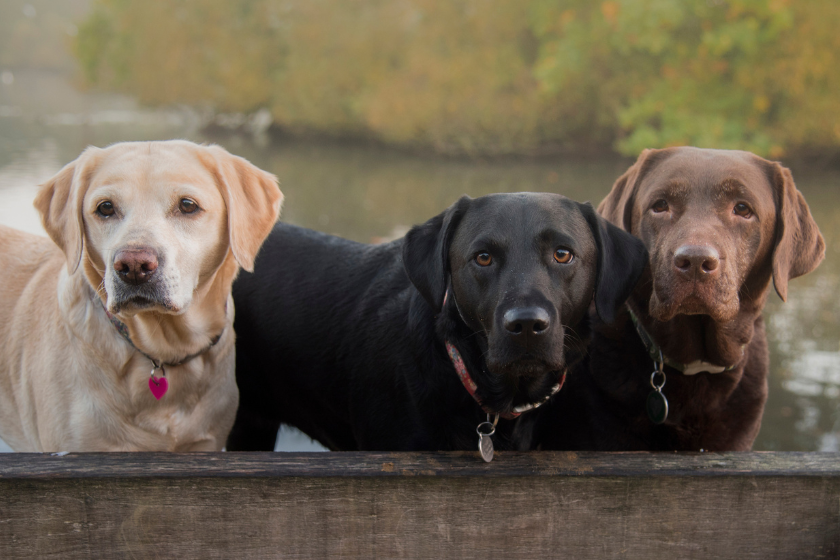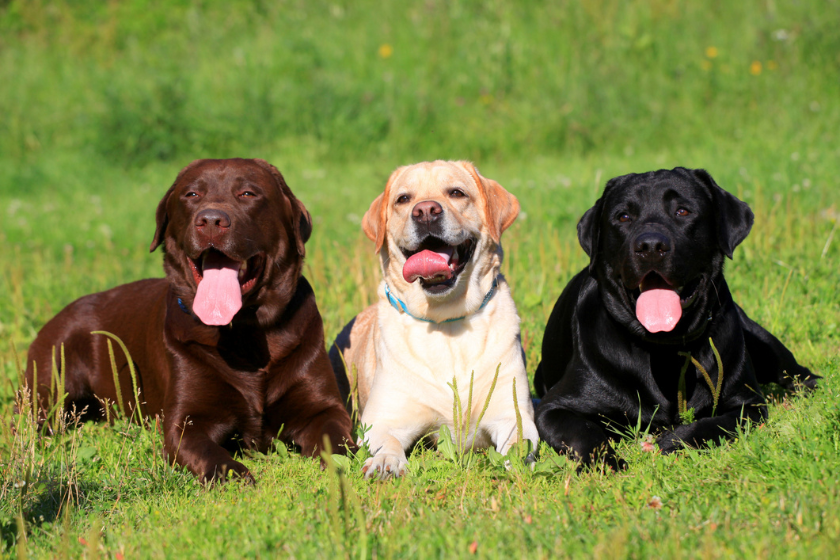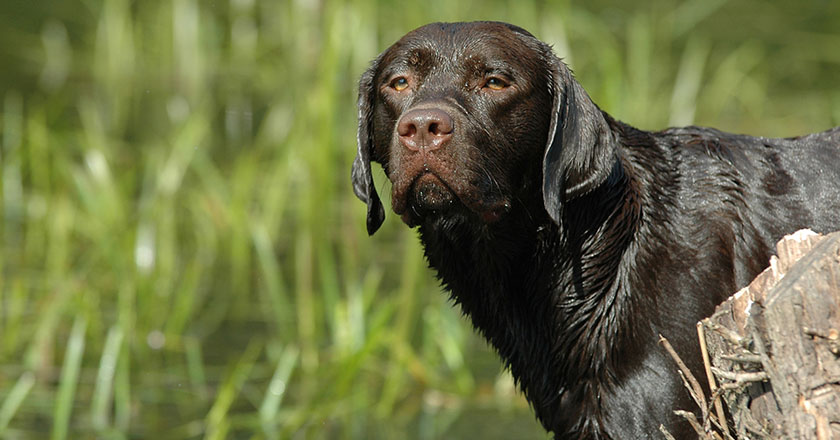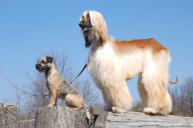It's hard to go anywhere without seeing a Labrador retriever. If you're alive today and under 30, chances are that the Labrador retriever has been the most popular dog breed for your entire life. This family-favorite breed has been top dog in the United States for more than three decades. Labrador retrievers can seem like generic dogs, but there are actually a couple of variations on the popular breed: English labs and American labs. Is the difference in name only, or is there more than meets the eye when it comes to this dog and its cousin across the pond?
Interestingly enough, the American Kennel Club and the UK Kennel Club do not differentiate between the two pups. Both organizations view them as one and the same: a Labrador retriever. While the world's two biggest dog authorities may not differentiate between the English lab vs. American lab, dog owners and breeders certainly do. The English Labrador and the American Labrador each have subtle quirks that only true lab lovers would notice.
Here's a look at the slight differences between American and English labs.
Where Do Labrador Retrievers Come From?

According to the American Kennel Club, the Labrador retriever originated in Newfoundland. The running theory is that European fishermen from Spain, France, England, and Portugal would come fish off the coast of Newfoundland and brought their pups along with them. Their pets ended up mixing with the local dogs, creating a new breed named after Newfoundland's capital: St. John's dog.
These mixed dogs quickly became known for their love of the water and talent for swimming. They would entertain crowds at the fishing docks by diving into the ocean and retrieving objects for their owners. Since the dogs were so useful, breeding them became a lucrative side hustle for the Canadian sailors. They began selling the pups to people in England and the St. John's water dog eventually became the genetic foundation for all modern British retrievers. The Earl of Malmesbury was especially impressed with the breed, realizing that one of these dogs would make the perfect duck hunting partner on his Heron Court Estate. The Earl noted that the dogs' fur "turns the water off like oil" and their otter-like tails made for efficient swimming, highlighting two of the Labrador retriever's most prominent features that are still prized today. He quickly ordered a breeding program and other English nobles became interested in the dogs, too. The dukes of both Buccleuch and Home in Scotland also brought dogs over from Newfoundland and worked to keep their bloodlines pure.
Meanwhile, the St. John's dog was having a hard time back in its home country with the government imposing heavy taxes on dogs that were not used for herding. The British had a hand in the breed's eventual demise, too. They imposed lengthy quarantines for any imported dog in an effort to control rabies, bringing the dog-dealing business between England and Newfoundland to a halt.
The Labrador retriever breed began to morph into the lovable pups that we have today largely because of a chance meeting between the Duke of Buccleuch, the Duke of Home, and Earl of Malmesbury at a waterfowl shoot in the late 1880s. Realizing that their dogs had similar bloodlines, the Earl sent two of his pups to Scotland, where the Buccleuch Labradors were first bred. While the Labrador pups initially all had black fur, dogs from later bloodlines eventually produced chocolate and yellow labs as well.
The original St. John's dogs back in Newfoundland eventually became extinct, with the last two surviving dogs recorded on the island in the late 1970s. While they're no longer around in their original form, these water-loving dogs led to the creation of what would eventually become the most popular dog breed in America. Labrador retrievers were officially accepted by the English Kennel Club in 1903 and the AKC in 1917, cementing the pups as the best breed for families.
English Lab vs American Lab

The main difference between English labs and American labs appear in their purpose, size, and appearance. English Labrador retrievers are bred more for dog shows and conformation to breed standards. It is far more common to find one of these pups in the show circuit compared to the American Labrador retriever. American labs were bred more for hunting and field trials, but they can still be show dogs just like English labs can be hunting dogs.
When comparing the two types of Labrador retrievers, their bodies highlight the biggest differences between the breeds and can be seen best when they stand side by side.
Some of the trademarks of an English Lab or bench-type are:
- Wide head with a barrel chest
- Thicker coat, with possibly waves down the back
- Wide tail resembling an otter tail
- Shorter legs
- Short and stocky body
- Bred closer to the breed standard
Conversely, the American Lab or field type features the following characteristics:
- Toned, athletic build
- Slimmer head
- Narrower, longer muzzle
- Thinner coat
- Longer legs with a taller build
- Thinner tail
- Loosely follows the breed standard
There is not a different set of standards for English labs vs. American labs. Instead, there is just one for Labrador retrievers as a whole. The breed standard says that on average a male Labrador Retriever stands between 22 to 24.5 inches tall and a female stands at 21 to 23.5 inches tall. Male Labs weigh between 65 and 80 pounds, while females weigh between 55 and 70 pounds.
The AKC lists the breed's accepted colors as yellow, black, and chocolate, all with a water-resistant double-coat. American chocolate labs are far more popular than English chocolates. Yellow labs are just as popular in both types.
Labrador Retriever Temperament, Lifespan, and Health Issues
Labrador retrievers make excellent companions and service dogs. They also work in search and rescue, drug and bomb detection, and with the TSA thanks to their intelligence and trainability. These sweet, loving dogs are known as the perfect family pet, which has lead to their popularity.
But don't let their loving, laid-back personality fool you: These pups were bred for work, which means they have high energy levels. Labs love to play and can spend hours playing fetch (they are a retriever breed, after all!), running around outside, and swimming. Lab puppies have even higher energy levels and need constant activity and attention. They are known for becoming very destructive if their exercise and activity needs aren't met. American labs are considered to be more active, while English labs tend to be calmer. Conversely, American labs tend to be more eager to please, and are considered easier to train.
Responsible breeders will screen their dogs for common health problems such as hip and elbow dysplasia. They will also do an eye check and an EIC DNA test to check for exercise-induced collapse, which can happen in young labs. Labs are also known for muscle weakness, which can be a hereditary trait. Since the English Labradors have a deeper chest, they are susceptible to stomach bloat. Both types of labs are prone to obesity and should eat high-quality dog food in moderation to stay healthy. The average lifespan of a Labrador retriever is 10 to 12 years.
Labrador Retriever Fast Facts

- Labrador Retrievers come from the island territory of Labrador in Newfoundland.
- They used to perform for crowds at the fishing docks diving into canals to retrieve objects like fish, rocks, and more.
- They were adopted by the AKC in 1917.
- Labs are used in search-and-rescue missions, sniff out drugs and bombs, and work as service dogs. They're also proficient at hunting and make talented show dogs.
- Labrador retrievers come in three colors: Chocolate, yellow, and black. While chocolate labs weren't originally a desirable color, they became more popular as time went on. Red labs are a variation of yellow labs. Silver labs are actually a variation of the chocolate lab, but are not recognized by the AKC.
- AKC labs can cost anywhere from $800 to $1,500 depending on color and lineage. Show type and field labs can cost quite a bit more depending on how many awards are in their bloodlines.




